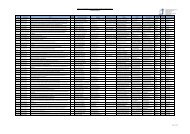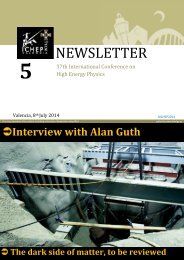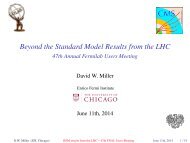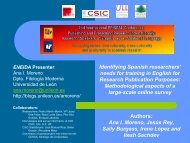PW_mar13_sample_issue
PW_mar13_sample_issue
PW_mar13_sample_issue
Create successful ePaper yourself
Turn your PDF publications into a flip-book with our unique Google optimized e-Paper software.
physicsworld.com<br />
This is an unparalleled<br />
glimpse into the inner<br />
workings and dynamics of<br />
many-body systems<br />
netic field on the electron is thus to introduce a phase<br />
shift φ on a closed-loop trajectory. Hence, if we are<br />
able to engineer such a phase shift in the wavefunction<br />
of a neutral atom by other means, we will have<br />
simulated essentially the same effect.<br />
Several possibilities have been outlined for doing<br />
this using quantum optical control techniques. One<br />
can, for example, engineer a Hamiltonian such that<br />
when an atom, initially prepared in a single quantum<br />
state, is moved slowly in space in a way that does not<br />
induce heating (adiabatically), no quantum jumps<br />
to other energy levels occur. For a suitable choice<br />
of Hamiltonian, the particle can pick up a phase<br />
during this state evolution – the so-called Berry’s<br />
phase – which depends on the geometric properties<br />
of the Hamiltonian. The Berry’s phase acquired<br />
in this adiabatic state evolution then formally corresponds<br />
to the Aharonov–Bohm phase shift of a<br />
charged particle.<br />
Another possibility is to use laser-assisted hopping<br />
of particles in an optical lattice to achieve the<br />
same net phase shift. Imagine two neighbouring lattice<br />
sites that are shifted in energy relative to each<br />
other, such that a single particle cannot move to<br />
the next site without some additional help, owing to<br />
energy conservation. Laser light tuned to the right<br />
frequency can provide this missing energy, allowing<br />
the particle to hop to the next site. Crucially, during<br />
this hopping process, the matter wave of the atoms<br />
inherits the phase of the optical wave. Laser-assisted<br />
hopping thus allows one to tune almost at will the<br />
phase shift produced when an atom hops from one<br />
lattice site to the next, and to render this phase shift<br />
position-dependent. For example, an atom hopping<br />
around a 2 × 2 plaquette in a lattice (figure 4) thus<br />
picks up a phase shift of φ = φ 1–φ 2 corresponding to<br />
the Aharonov–Bohm phase shift an electron would<br />
pick up when hopping around a lattice plaquette<br />
while being exposed to a magnetic field.<br />
The interesting thing about this second possibility<br />
is that in real materials, the achieved phase shift is<br />
limited by the strength of the applied magnetic field<br />
and is typically small. For ultracold atoms, however,<br />
such phase shifts can be tuned to any value between<br />
φ = 0 and π. In a real material, one would need to<br />
apply a magnetic field of several thousands of tesla –<br />
some two orders of magnitude greater than the fields<br />
generated by today’s strongest research magnets – to<br />
achieve the same effect. How will matter behave<br />
under such extreme field strengths? The answer is<br />
that we don’t really know – we cannot calculate it,<br />
which is why it is worth doing the simulations. Some<br />
theorists have predicted that one might encounter<br />
states that are closely related to those of the frac-<br />
Quantum frontiers: Quantum simulation<br />
4 Realization of artificial magnetic fields<br />
a b<br />
tional quantum Hall effect in 2D electron gases.<br />
However, there is also real potential for discovering<br />
new phases of matter.<br />
As you might imagine, there are plenty of pathways<br />
ahead for future research. One possibility would<br />
be to extend high-resolution imaging techniques<br />
to fermionic atoms, or even to polar molecules,<br />
which have strong electric dipole moments that give<br />
rise to long-range interactions. Being able to study<br />
such interactions at high resolution might bring an<br />
intriguing new perspective to our understanding of<br />
quantum matter. Topological phases of matter with<br />
new forms of excitations, such as Majorana fermions<br />
– an elusive particle that is its own anti-particle, and<br />
has only recently been discovered in a condensedmatter<br />
setting – could be realized and probed with<br />
ultracold atoms.<br />
Another fundamental topic that is currently much<br />
debated concerns how isolated quantum systems<br />
come into thermal equilibrium; more specifically,<br />
it would be interesting to know which observables<br />
show thermal-like behaviour after a certain evolution<br />
time. Being able to probe, with high spatial<br />
resolution, how non-local correlations in the system<br />
evolve in time would offer an exciting new way to<br />
unravel the secrets of these dynamics. One can only<br />
speculate, but I am sure Feynman would have been<br />
fascinated to see how far we have come in realizing<br />
his vision of a quantum simulator and the possibilities<br />
it offers for future research.<br />
n<br />
More about: Quantum simulation<br />
2012 Nature Physics Insight: Quantum simulation Nature<br />
Phys. 8 263<br />
J Dalibard, F Gerbier, G Juzeliu − nas and P Öhberg 2011<br />
Colloquium: Artificial gauge potentials for neutral atoms<br />
Rev. Mod. Phys. 83 1523<br />
R P Feynman 1982 Simulating physics with computers Int. J.<br />
Theor. Phys. 21 467<br />
D Jaksch and P Zoller 2005 The cold atoms Hubbard toolbox<br />
Ann. Phys. 315 52<br />
Physics World March 2013 51<br />
B<br />
e –<br />
eiφ AB<br />
y<br />
e iφ 1<br />
φ<br />
e –iφ 2<br />
(a) An electron in a magnetic field B experiences a phase shift φ AB caused by the Aharonov–<br />
Bohm effect as it traverses a closed loop. (b) A similar phase shift can be achieved for<br />
neutral atoms in an optical lattice by using a laser to make them “hop” around a 2 × 2 region<br />
of the lattice. Each hop along the x-direction imprints a phase shift φ i that depends on the<br />
y-position of the particle. The net phase shift of the neutral atom hopping around the closed<br />
path shown is then given by φ = φ 1 – φ 2, corresponding to an “effective magnetic field”.<br />
x








